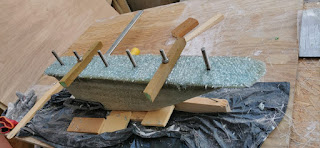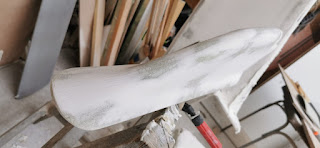Skeg jest płytą laminatową o grubości 40 mm, przy dnie rozszerza się do 80 mm. W skegu osadzone jest równolegle 6 śrub M10. Śruby powinny być wykonane ze stali AISI 316. Skeg można wykonać na kilka sposobów, powiemy o dwóch.
Pierwszy sposób to wykonanie prostej, jednorazowej formy ze sklejki i listew. Wewnętrzny kształt formy powinien odpowiadać kształtowi skegu. Wnętrze formy woskujemy pięciokrotnie a następnie laminujemy w nim skeg. Gdy już nie można ułożyć maty szklanej na ściankach pozostałą przestrzeń wypełniamy żywicą i ciętą lub rozrywaną matą szklaną. Staramy się by szkła było jak najwięcej. W odpowiednim momencie w skegu osadzamy śruby tak by były zagłębione na 60 mm. Powierzchnia skegu wykonanego w formie będzie gładka.
Drugi sposób to wykonanie modelu skegu . Model powinien mieć grubość mniejszą z każdej strony o 2 mm. Model pokrywamy warstwą rozdzielającą. Teraz możemy model polaminować dwiema warstwami maty 600 G/m2. Po utwardzeniu laminatu wyjmujemy model. Wnętrze należy przeszlifować i odtłuścić np. acetonem. Teraz tak jak w pierwszej metodzie wnętrze wypełniamy ciętą matą i żywicą oraz osadzamy śruby na właściwej głębokości. Powierzchnia skegu wykonanego na modelu wymaga szlifowania i szpachlowania.
Skeg przyklejamy do dna żywicą epoksydową i przykręcamy śrubami.
Skeg is a 40 mm thick laminate board, at the bottom of the boat it expands to 80 mm. Six M10 screws are mounted in parallel in the skeg. The bolts should be made of AISI 316 steel. Skeg can be made in several ways, we will say two.
The first way is to make a simple, disposable mold out of plywood and slats. The inner shape of the mold should follow the shape of the skeg. We wax the interior of the mold five times and then laminate the skeg in it. When the glass mat cannot be placed on the walls, the remaining space is filled with resin and a cut or torn glass mat. We try to make the glass as much as possible. At the right moment, put the screws in the skeg so that they are recessed by 60 mm. The surface of the skeg made in the form will be smooth.
The second way is to make a skeg model. The model should be 2 mm thinner on all sides. The model is covered with a separating layer. Now we can laminate the model with two layers of 600 G / m2 mat. After the laminate is cured, remove the model. The interior should be sanded and degreased, e.g. with acetone. Now, just like in the first method, we fill the interior with cut mat and resin and put the screws at the right depth. The surface of the skeg made on the model requires grinding and puttying.
We glue the skeg to the bottom with epoxy resin and screw it with screws.






















